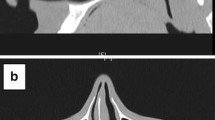Abstract
The aim of this study is to evaluate the long-term results of endoscopic sinus surgery in the treatment of antrochoanal polyps and the role of extending the middle meatal antrostomy on the expense of the inferior meatus in providing wide exposure and accessibility within the maxillary sinus to ensure complete removal of its antral portion. Thirty-six patients were reviewed. Two groups were identified: Group A including patients with antrochoanal polyps that were resected endoscopically through a classical wide middle meatal antrostomy and Group B which included those who underwent endoscopic removal via an extension of the antrostomy inferiorly through submucosal resection of the lateral bony skeleton of the inferior meatus. There were 13 female and 23 male patients with a mean age of 28 ± 9.4 years. The mean follow-up period was 20.4 ± 6.7 months. Six patients were recurrent after previous endoscopic surgery. Group A included 17 patients and the remaining 19 patients were assigned to Group B. Two patients from Group A developed symptomatic recurrence and were cured with revision extended antrostomy. Three patients showed endoscopic evidence of a developing cystic lesion within the maxillary sinus that was punctured through the wide antrostomy. Endoscopic resection is considered the main treatment modality of antrochoanal polyps. Modification of the technique through removal of the lateral bony skeleton of the inferior meatus with downward displacement of the inferior turbinate provided accessibility to the inferior and prelacrimal recesses of the maxillary sinus.






Similar content being viewed by others
References
Min YG, Chung JW, Shin JS, Chi JG (1995) Histologic structure of antrochoanal polyps. Acta Otolaryngol 115:543–547
Heck WE, Hallberg OE, Williams HL (1950) Antrochoanal polyp. Arch Otolaryngol 52:538–548
Sirola R (1966) Choanal Polyps. Acta Ololaryngol 61:42–48
Chen JM, Schloss MD, Azouz ME (1989) Antro-choanal polyp: a 10-year retrospective study in the pediatric population with a review of the literature. J Otolaryngol 18:168–172
Kamel R (1990) Endoscopic transnasal surgery in antrochoanal polyp. Arch Otolaryngol Head Neck Surg 116:841–843
Ophir D, Marshak G (1987) Removal of antral polyp through an extended nasoantral window. Laryngoscope 97:1356–1357
El-Guindy A, Mansour MH (1994) The role of transcanine surgery in antrochoanal polyps. J Laryngol Otol 108:1055–1057
Hosemann W, Scotti O, Bentzien S (2003) Evaluation of telescopes and forceps for endoscopic transnasal surgery on the maxillary sinus. Am J Rhinol 17:311–316
Sathananthar S, Nagaonkar S, Paleri V, Le T, Robinson S, Wormald PJ (2005) Canine fossa puncture and clearance of the maxillary sinus for the severely diseased maxillary sinus. Laryngoscope 115:1026–1029
Robinson S, Wormald PJ (2005) Patterns of innervation of the anterior maxilla: a cadaver study with relevance to canine fossa puncture of the maxillary sinus. Laryngoscope 115:1785–1788
Byun JY, Lee JY, Baek BJ (2011) Weakness of buccal branch of facial nerve after canine fossa puncture. J Laryngol Otol 125:214–216
Costa F, Polini F, Zerman N, Robiony M, Toro C, Politi M (2007) Surgical treatment of Aspergillus mycetomas of the maxillary sinus: review of the literature. Oral Surg Oral Med Oral Pathol Oral Radiol Endod 103:23–29
Chobillon MA, Jankowski R (2004) What are the advantages of the endoscopic canine fossa approach in treating maxillary sinus aspergillomas? Rhinology 42:230–235
Robinson SR, Baird R, Le T, Wormald PJ (2005) The incidence of complications after canine fossa puncture performed during endoscopic sinus surgery. Am J Rhinol 19:203–206
Tewfik MA, Wormald PJ (2010) Planning for the canine fossa trephination approach. Oper Tech Otolaryngol Head Neck Surg 21:150–154
Yanagisawa E, Joe J (1997) Inferior meatal antrostomy: is it still indicated? Ear Nose Throat J 76:368–370
Lund VJ (1988) Inferior meatal antrostomy. Fundamental considerations of design and function. J Laryngol Otol Suppl 15:1–18
Hinohira Y, Hyodo M, Gyo K (2009) Submucous inferior turbinotomy cooperating with combined antrostomies for endonasal eradication of severe and intractable sinusitis. Auris Nasus Larynx 36:162–167
Ochi K, Sugiura N, Komatsuzaki Y, Nishino H, Ohashi T (2003) Patency of inferior meatal antrostomy. Auris Nasus Larynx 30:S57–S60
Moeller CW, Stankiewicz JA (2010) Endoscopic inferior meatal antrostomy. Oper Tech Otolaryngol Head Neck Surg 21:156–159
Zhou B, Han DM, Cui SJ, Huang Q, Wang CS (2013) Intranasal endoscopic prelacrimal recess approach to maxillary sinus. Chin Med J 126:1276–1280
Navarro Pde L, Machado Júnior AJ, Crespo AN (2013) Evaluation of the lacrimal recess of the maxillary sinus: an anatomical study. Braz J Otorhinolaryngol 79:35–38
Lund VJ (1986) Fundamental considerations of the design and function of intranasal antrostomies. J R Soc Med 79:646–649
Sarber KM, Weitzel EK, O’Connor P (2013) Surgical relationship of the nasolacrimal system to the anterior maxillary line: performing safe mega-antrostomy. Otolaryngol Head Neck Surg 149(2 supp):135–136
Tatlisumak E, Aslan A, Cömert A, Ozlugedik S, Acar HI, Tekdemir I (2010) Surgical anatomy of the nasolacrimal duct on the lateral nasal wall as revealed by serial dissections. Anat Sci Int 85:8–12
Lee TJ, Huang SF (2006) Endoscopic sinus surgery for antrochoanal polyps in children. Otolaryngol Head Neck Surg 135:688–692
Piquet JJ, Chevalier D, Leger GP, Rouquette I, Leconte-Houcke M (1992) Endonasal microsurgery of antro-choanal polyps. Acta Otorhinolaryngol Belg 46:267–271
Hiranandani LH, Melgiri RD (1966) Expansion of antrum by an antrochoanal polypus. J Laryngol Otol 80:175–177
Conflict of interest
I declare no conflict of interest.
Author information
Authors and Affiliations
Corresponding author
Rights and permissions
About this article
Cite this article
Nour, Y.A. Variable extent of nasoantral window for resection of antrochoanal polyp: selection of the optimum endoscopic approach. Eur Arch Otorhinolaryngol 272, 1127–1134 (2015). https://doi.org/10.1007/s00405-014-3178-0
Received:
Accepted:
Published:
Issue Date:
DOI: https://doi.org/10.1007/s00405-014-3178-0




